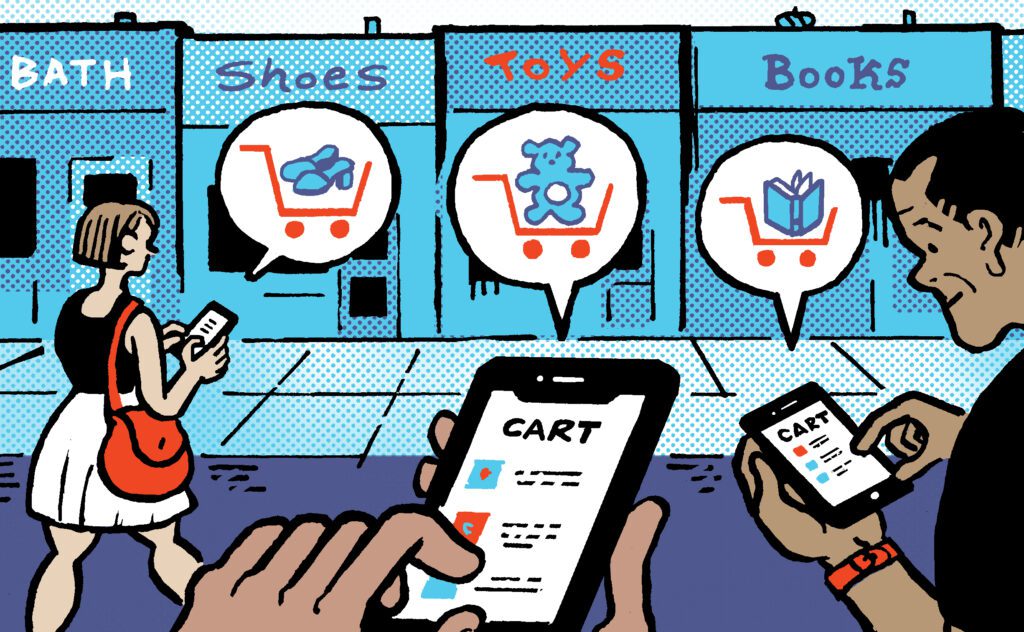The retail media boom isn’t just for Amazon and brick-and-mortar chains.
Online marketplaces are also investing heavily in ad platform businesses, albeit for different reasons.
Etsy and eBay, two of the most prominent non-Amazon online marketplaces, both reported 2022 year-end earnings on Wednesday – and both framed advertising as a fast-growing revenue pillar with important implications for their respective core retail businesses.
A betsy on Etsy
Etsy’s market cap is down by more than half since highs in November 2021 and its stock dropped sharply after the company reported earnings.
Fourth quarter revenue was down 4% YoY and full-year revenue decreased by 1%.
But Etsy has been pushing hard to boost its ad business.
In 2020, it made advertising mandatory for sellers who earn more than $10,000 per year, and last year increased its share of marketplace transactions from 5% to 6.5%. In other words, Etsy began requiring sellers to re-spend a portion of sales on offsite ads and started taking a larger fee on all sales it drives back to the site.
While Etsy’s ecommerce marketplace revenue was up only slightly – thanks mainly to the increased fee – its services revenue, which includes advertising, was up 17% for the year.
Advertising revenue was up 20%, CFO Rachel Glaser told investors – although the company doesn’t break out its advertising revenue, only the percent growth rate.
Performance marketing spend for the Etsy marketplace drove $2.5 billion in revenue in 2022, up roughly $200 million from the year before.
Etsy’s ad hybrid
For ecommerce marketplaces like Etsy and eBay, their ad business is inextricably connected to their own ad spend.
Offsite ads are the clearest example. These ads promote individual sellers, who also contribute spend, but Etsy controls the budget, the experience is branded as Etsy and visitors are taken to Etsy product pages.
Improving the ad platform for advertisers is therefore part of Etsy’s own marketing push.
The Etsy Advertising group drove $100 million in incremental gross merchandise sales last year “by improving the data feeds to our advertising partners and affiliate channels, improving search engine optimizations,” said Etsy CEO Josh Silverman.
Silverman also said that Etsy tested podcast ads and digital out-of-home placements in 2022 with positive results.
“And, fun fact, we drove about $100 million in incremental annualized (gross merchandise sales) just from improving our email campaigns,” he said.
Silverman added that increased investments in “upper-funnel branding strategies” over the past five years have “significantly moved the needle” on purchase intent and online ad metrics, such as conversions rates.
eBay sells an advertising turnaround
For eBay, advertising is already a significant revenue line that the company has reported for years.
The ad business brought in $319 million in revenue in Q4 2022, and eBay’s first-party ad products, which include newer machine learning-based solutions where eBay takes control of ad campaigns, are now $276 million and grew at a rate of 27% last year.
“Our advertising revenue continues to meaningfully outpace volume growth,” eBay CFO Steve Priest told investors.
Still, gross merchandise volume (GMV) was down 12% YOY, so advertising growth is more so offsetting losses rather than adding to gains.
But, similar to Etsy, eBay is demonstrating how ad platform improvements can benefit the overall marketplace.
For example, eBay’s merchandizing algorithms have gotten better at showing a diversity of products, Priest said, which has led to higher customer satisfaction scores and conversion rates.
And eBay’s advertising business has considerable room to grow. Although eBay doesn’t regularly disclose how much advertising is responsible for sales, CEO Jamie Iannone told investors that advertising is now almost 1.8% of GMV.
With that stat in mind, Evercore investment analyst Mark Mahaney asked how high the number might be expected to rise.
“On the ad side, we have a line of sight to 3%,” Iannone responded.
While that’s still well below Amazon, where advertising is between 5% and 6% of GMV, eBay hopes its ads business will enhance the core marketplace.
“Our marketplace continues to benefit from innovation in our advertising business,” Iannone said, “which delivered strong growth in Q4 despite headwinds in the broader digital ad market.”















